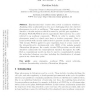Free Online Productivity Tools
i2Speak
i2Symbol
i2OCR
iTex2Img
iWeb2Print
iWeb2Shot
i2Type
iPdf2Split
iPdf2Merge
i2Bopomofo
i2Arabic
i2Style
i2Image
i2PDF
iLatex2Rtf
Sci2ools
BIRD
2007
Springer
2007
Springer
Analysing Periodic Phenomena by Circular PCA
Experimental time courses often reveal a nonlinear behaviour. Analysing these nonlinearities is even more challenging when the observed phenomenon is cyclic or oscillatory. This means, in general, that the data describe a circular trajectory which is caused by periodic gene regulation. Nonlinear PCA (NLPCA) is used to approximate this trajectory by a curve referred to as nonlinear component. Which, in order to analyse cyclic phenomena, must be a closed curve hence a circular component. Here, a neural network with circular units is used to generate circular components. This circular PCA is applied to gene expression data of a time course of the intraerythrocytic developmental cycle (IDC) of the malaria parasite Plasmodium falciparum. As a result, circular PCA provides a model which describes continuously the transcriptional variation throughout the IDC. Such a computational model can then be used to comprehensively analyse the molecular behaviour over time including the identification ...
| Added | 07 Jun 2010 |
| Updated | 07 Jun 2010 |
| Type | Conference |
| Year | 2007 |
| Where | BIRD |
| Authors | Matthias Scholz |
Comments (0)

